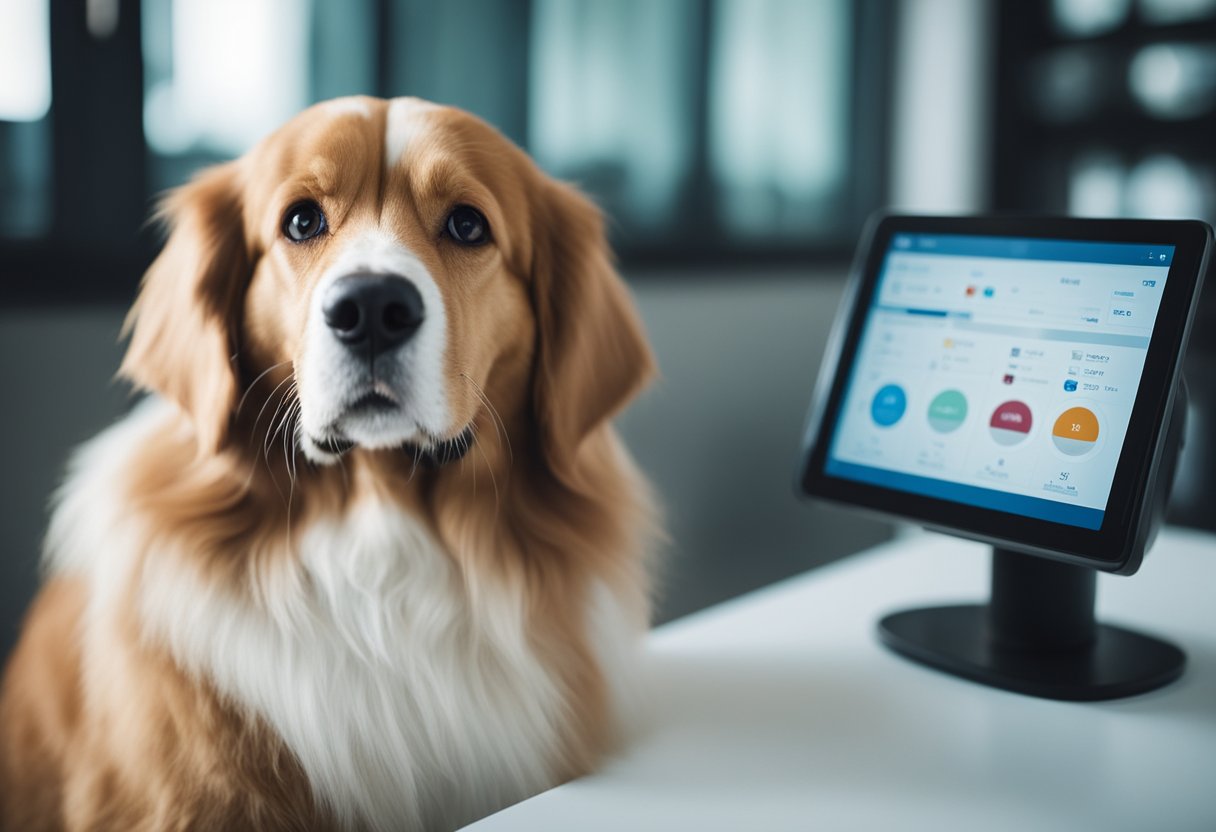As we explore the world of pet health, it’s become clear that obesity in our furry friends is a rising concern, much like it is for humans. With an array of pet diets and exercise regimens available, it can be overwhelming to ensure our pets get the right balance. This is where artificial intelligence (AI) steps in, offering innovative tools to prevent pet obesity and tailor dietary plans to our pets’ specific needs.
AI’s role extends beyond simple calorie tracking; it includes monitoring activity levels, analyzing dietary needs, and even creating personalized feeding programs. These technologies bring a new level of precision to pet care, allowing us to make informed decisions about their health and well-being. With AI, we can transform the way we manage pet obesity, turning a daunting task into a manageable one.
Key Takeaways
- Artificial intelligence provides advanced tools for managing pet diet and obesity.
- Personalized pet care is enhanced with AI’s precise monitoring and analysis.
- AI makes preventing and managing pet obesity more accessible for owners.
Understanding Pet Obesity
We’ve all heard the term “obesity,” but when it comes to our furry friends, are we fully aware of what that means and how it can affect them? Understanding the risks and underlying factors leading to obesity in pets is the first step toward a healthier lifestyle for our beloved animals.
Defining Obesity in Pets
Obesity in pets is defined as an excess of body fat sufficient to impair health, mobility, and quality of life. This condition occurs when our pets consume more calories than they burn, leading to an accumulation of fat tissue. It’s important to note that being overweight is different from being obese; obesity is usually recognized when a pet’s body weight is at least 20% higher than its optimal weight.
Causes of Weight Gain in Pets
The reasons behind weight gain in pets can be multifaceted. Causes of obesity in pets include:
- Overfeeding: Providing too many calories, often through an excessively generous diet or through frequent treats and table scraps.
- Lack of exercise: A sedentary lifestyle contributes signficantly to pets gaining unnecessary weight.
- Metabolic disorders: Conditions such as hypothyroidism can slow metabolism, making weight control more challenging.
- Age: Older pets may be less active and have slower metabolisms, leading to a propensity for weight gain.
Understanding these causes can help us make better lifestyle choices for our pets.
AI and Nutritional Science
The advent of Artificial Intelligence (AI) has revolutionized the way we approach health and nutrition for our pets. By leveraging complex algorithms and rich datasets, AI is empowering us to tailor pet diets with unprecedented precision, ensuring that each furry friend gets exactly what they need for a healthy life.
Personalized Pet Diet Plans
Creating personalized diet plans for pets is now more accurate thanks to AI’s ability to analyze vast amounts of data. From a pet’s activity level to their genetic predispositions, AI can take into account various factors that influence dietary needs. For instance, using AI to craft the perfect diet for pets, helps integrate information like breed-specific requirements, age, weight, and health conditions to craft individualized meal plans. This custom approach helps mitigate the risk of obesity and related health issues by ensuring ideal nutrient intake.
Predictive Analysis for Diet Optimization
With predictive analysis, AI goes beyond just reacting to health needs; it anticipates them, allowing for real-time adjustments to diet plans. By analyzing trends and forecasting potential health risks, AI support systems can suggest dietary changes before problems become more serious. This proactive approach helps maintain optimal weight and health by predicting future dietary needs based on current data, lifestyle changes, or evolving health conditions, ensuring that our pets stay on the path to a balanced diet and a healthy life.
Activity Monitoring and Diet Management
We’ve embraced the power of emerging technologies to better understand and manage the health of our pets. With the integration of AI in activity trackers and diet management tools, we can now keep a closer watch on their exercise routines while tailoring their diets to match their precise needs.
AI-Integrated Activity Trackers
AI-integrated activity trackers have revolutionized the way we monitor our pets’ fitness levels. These devices not only track steps and playtime but also interpret behaviors to give us a more accurate picture of their overall well-being. By harnessing data on rest periods, play, and daily movement patterns, AI-driven insights can alert us to potential issues before they become serious. For instance, changes in activity could indicate health problems that might require dietary adjustments or a visit to the vet.
Dietary Adjustments Based on Activity
Once we have a clear understanding of our pets’ activity levels, we can make smarter dietary adjustments. The AI technology in these trackers syncs with smart feeding devices, allowing us to control portions and feed our pets the optimal amount of food based on their activity. This synchronization means that after an especially active day, our pets can be fed a little more to replenish their energy, and on lazier days, the portions can be automatically reduced to prevent weight gain. Thus, each meal is personalized, preventing pet obesity and supporting a healthy lifestyle.
Interactive Feeding Solutions
As technology evolves, so does our approach to pet care. We’re thrilled to introduce interactive feeding solutions that are designed to keep your pet healthy and happy. By leveraging the latest in smart technology, we’re now able to offer precise ways to manage your pet’s diet and prevent obesity, all with a user-friendly touch.
Smart Feeders and Portion Control
Smart feeders have revolutionized how we manage our pets’ diets. These devices allow us to set exact portion sizes and feeding times, ensuring that our pets get the right amount of food as recommended by veterinarians. By using programmable feeders, we take the guesswork out of meal times, removing the risk of overfeeding which is often a contributing factor to pet obesity.
- Pre-set feeding schedules: We can now time our pet’s meals to the minute, aligning their eating habits with their dietary needs.
- Portion precision: Each meal is dispensed with the correct portion, tailored to the pet’s size, breed, and activity level.
- Remote adjustments: Should our pet’s needs change, we can easily adjust the settings via an app, ensuring their diet evolves with them.
Real-Time Food Intake Tracking
Real-time food intake tracking is the future of pet diet management. With an AI-powered pet obesity tool, we can use a camera to monitor and analyze your pet’s eating habits. This is more than just a fancy feature; it’s an essential tool that gives us live feedback on our pet’s nutrition and helps us make informed decisions on their health.
- Live monitoring: You can watch your pet eat in real time, giving you peace of mind that they’re sticking to their diet, even when you’re not home.
- Health insights: The AI tool provides valuable data that can be shared with your vet, giving a clearer picture of your pet’s health and nutrition.
Interactive feeding solutions empower us to be more proactive in managing our pet’s health, ensuring they maintain a balanced diet and lead a more joyful, active life. Through smart feeders and AI, we’re not just feeding our pets – we’re providing them with a lifestyle that is healthy, controlled, and lovingly overseen.
Owner Education and Engagement

We’ve seen the positive impact that tailored guidance can have on pet health, and it’s clear that educating pet owners is crucial in preventing pet obesity. By integrating AI-driven tools, we are not only enhancing the way owners understand and manage their pets’ diets but also fostering a supportive community committed to pet welfare. Let’s explore how technology is changing the game.
AI-Driven Coaching for Pet Owners
AI technology is revolutionizing the way we approach pet nutrition and obesity prevention. With custom-designed apps, we can offer personalized pet diet plans and track progress with ease. For example, an AI-powered app can suggest the optimal food portions and recommend balanced meal choices based on the pet’s breed, age, and activity level. These smart programs can also remind owners when it’s time for their furry friends’ next meal or vet appointment, as seen with platforms promising to aid in finding the right diets for pets with specific needs.
Community Building Through Technology
But it’s not just about individual owners and their pets; technology also plays a role in creating powerful communities. Through online forums and social media groups, pet owners can connect and share experiences, tips, and success stories. This sense of community encourages a sustained engagement with pet health goals, backed by the support and inspiration of fellow pet enthusiasts. Such technology-driven communities can be a significant resource for owners, offering peer advice and moral support, which can be as valuable as professional guidance.
Frequently Asked Questions
We’ve gathered some common inquiries about the intersection of AI and pet health, with special emphasis on fighting obesity and managing diets. These are areas where technology can truly make a difference in our pets’ lives.
How does AI contribute to personalized nutrition plans for pets?
AI analyzes data about a pet’s breed, age, activity level, and current health to create personalized nutrition plans. This approach helps cater to the individual dietary needs of pets.
What technologies are available to help monitor a pet’s dietary health?
Technologies including AI-driven apps and platforms provide insights into a pet’s eating habits, helping track their dietary health so owners can make informed decisions.
In what ways can AI utilization in fitness trackers improve a pet’s weight management?
Fitness trackers with AI can monitor a pet’s activity, offering data that assists in creating effective weight management plans. These plans can recommend exercise suited to the pet’s health status and weight objectives.
Can artificial intelligence provide early warning signs of obesity in pets?
Indeed, AI can flag potential early warning signs by analyzing trends in a pet’s weight and eating patterns, prompting owners to make necessary dietary or lifestyle changes.
How is AI integrated into pet food dispensers for weight control?
Pet food dispensers equipped with AI can control portion sizes and feeding times, playing a pivotal role in weight control and helping to prevent overfeeding.
What are the benefits of using digital health tools in tracking a pet’s physical activity?
Digital health tools provide detailed insights into a pet’s physical activity, enabling owners to ensure their pets are getting enough exercise for their specific needs and towards maintaining a healthy weight.

